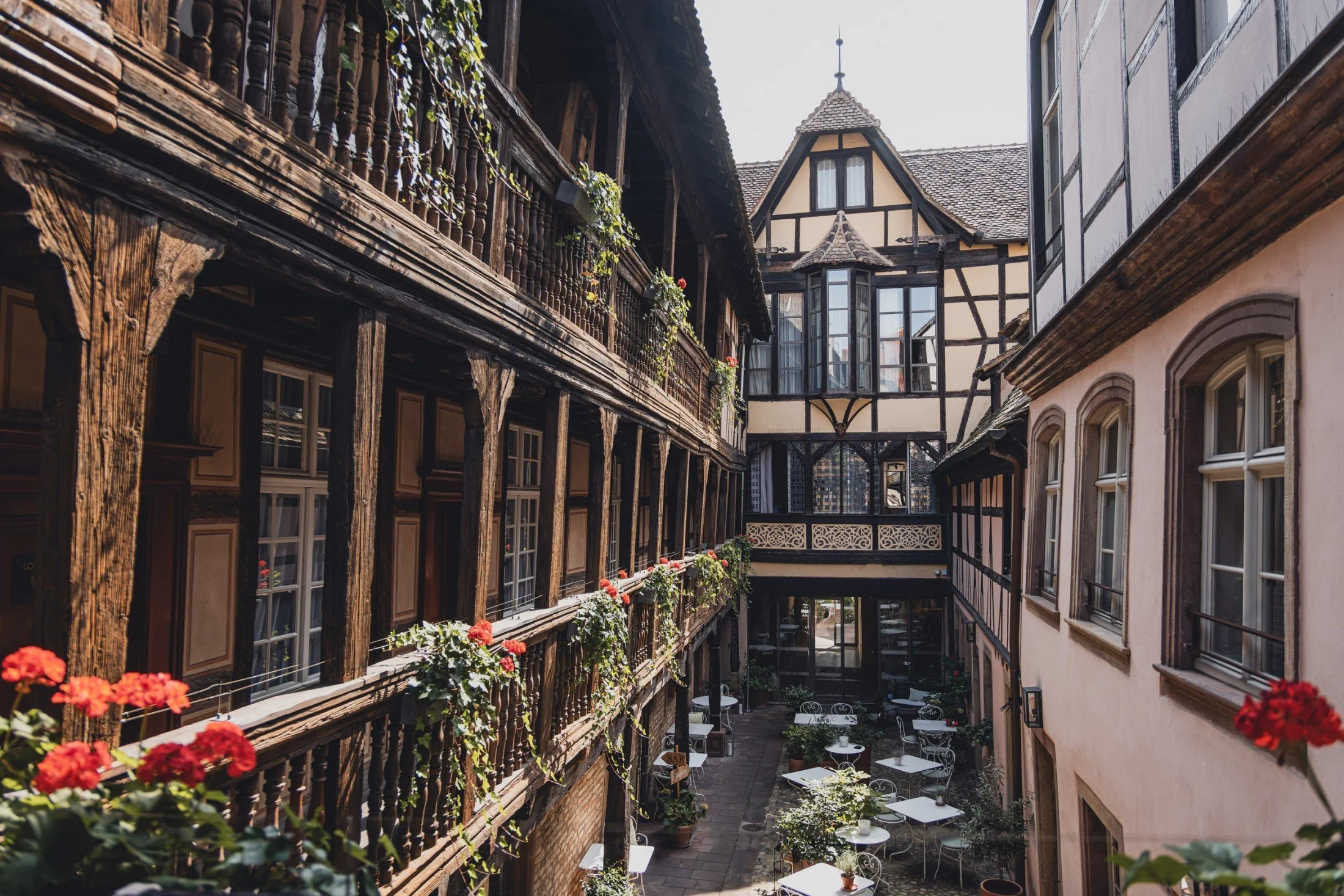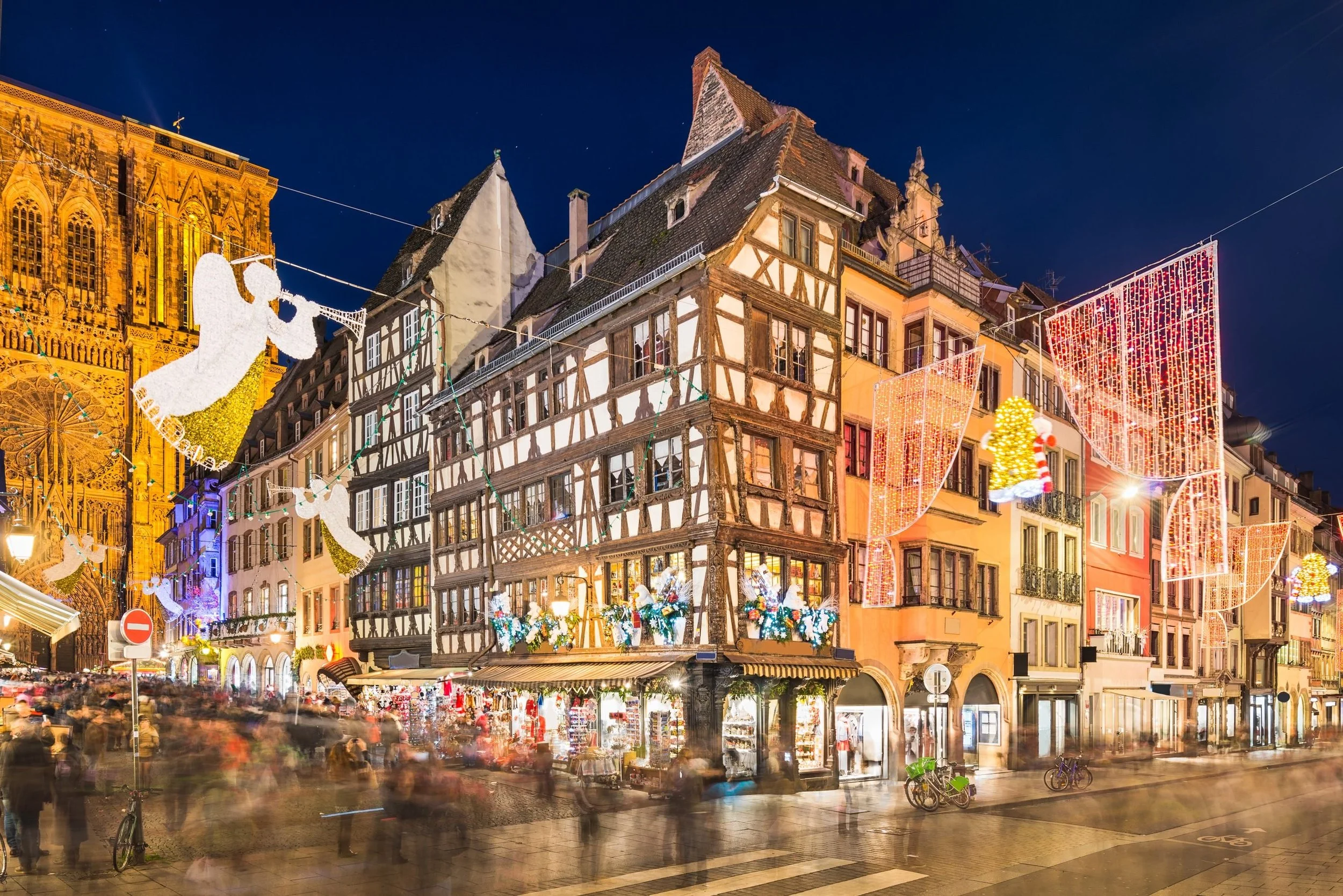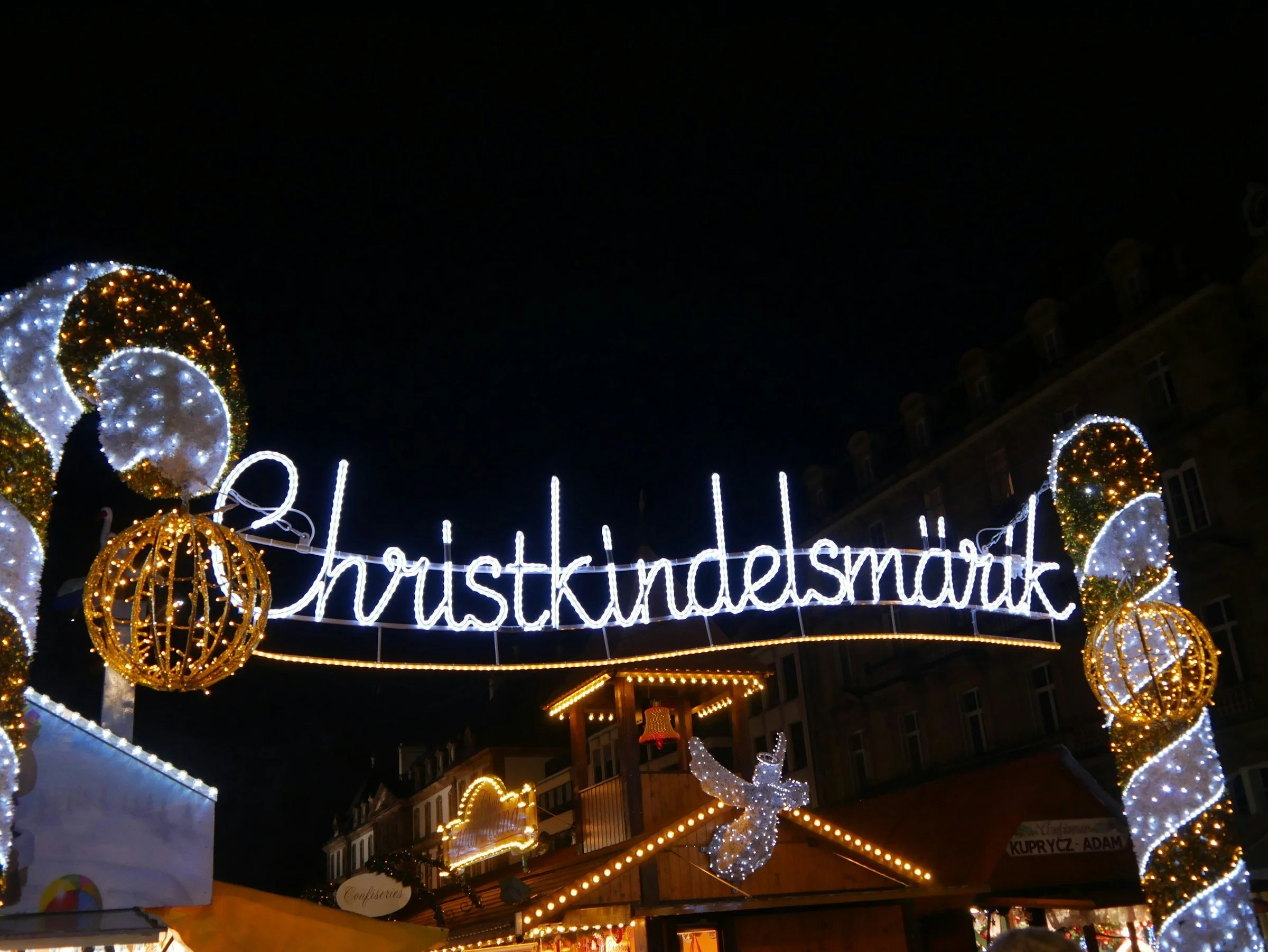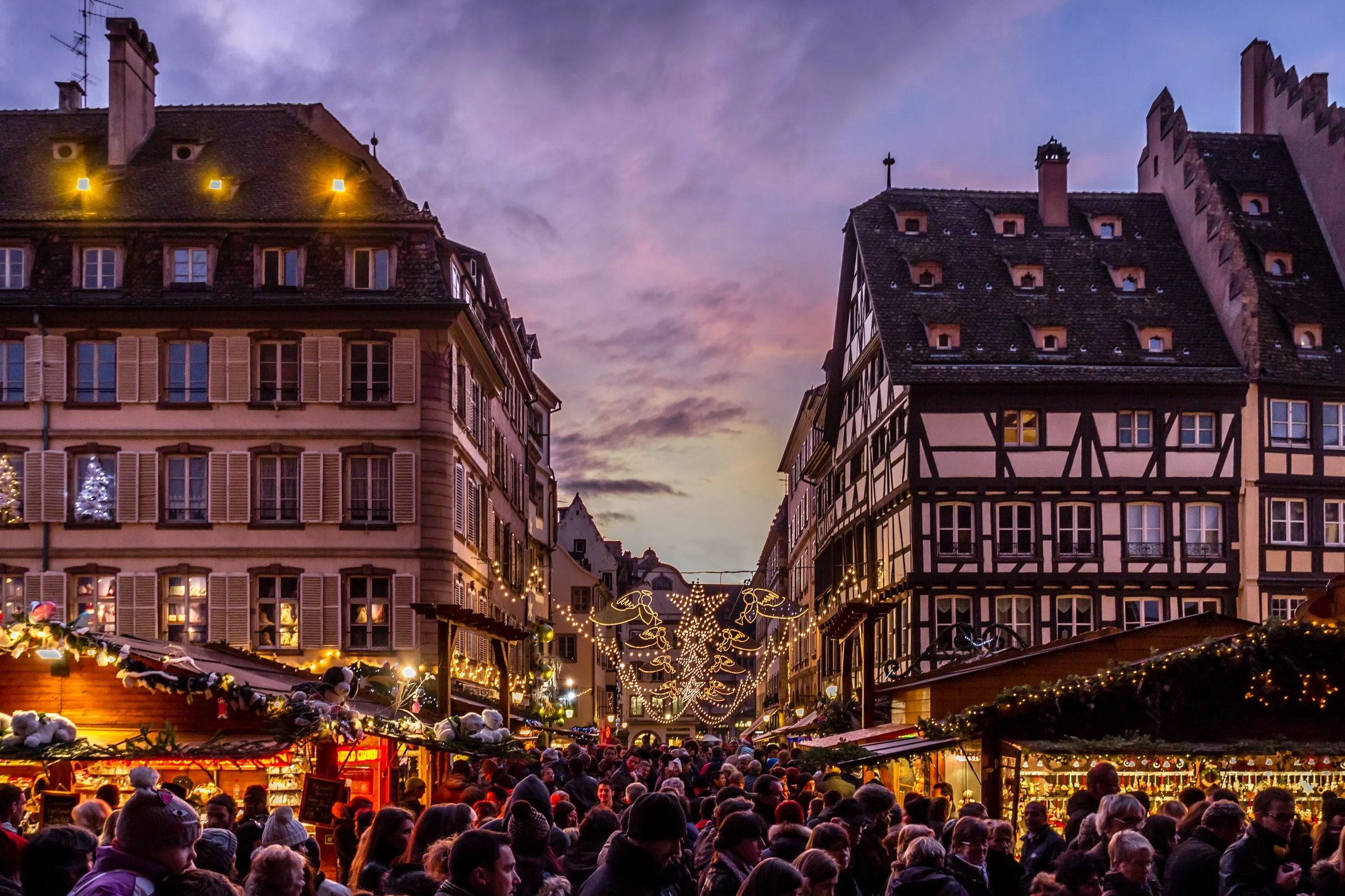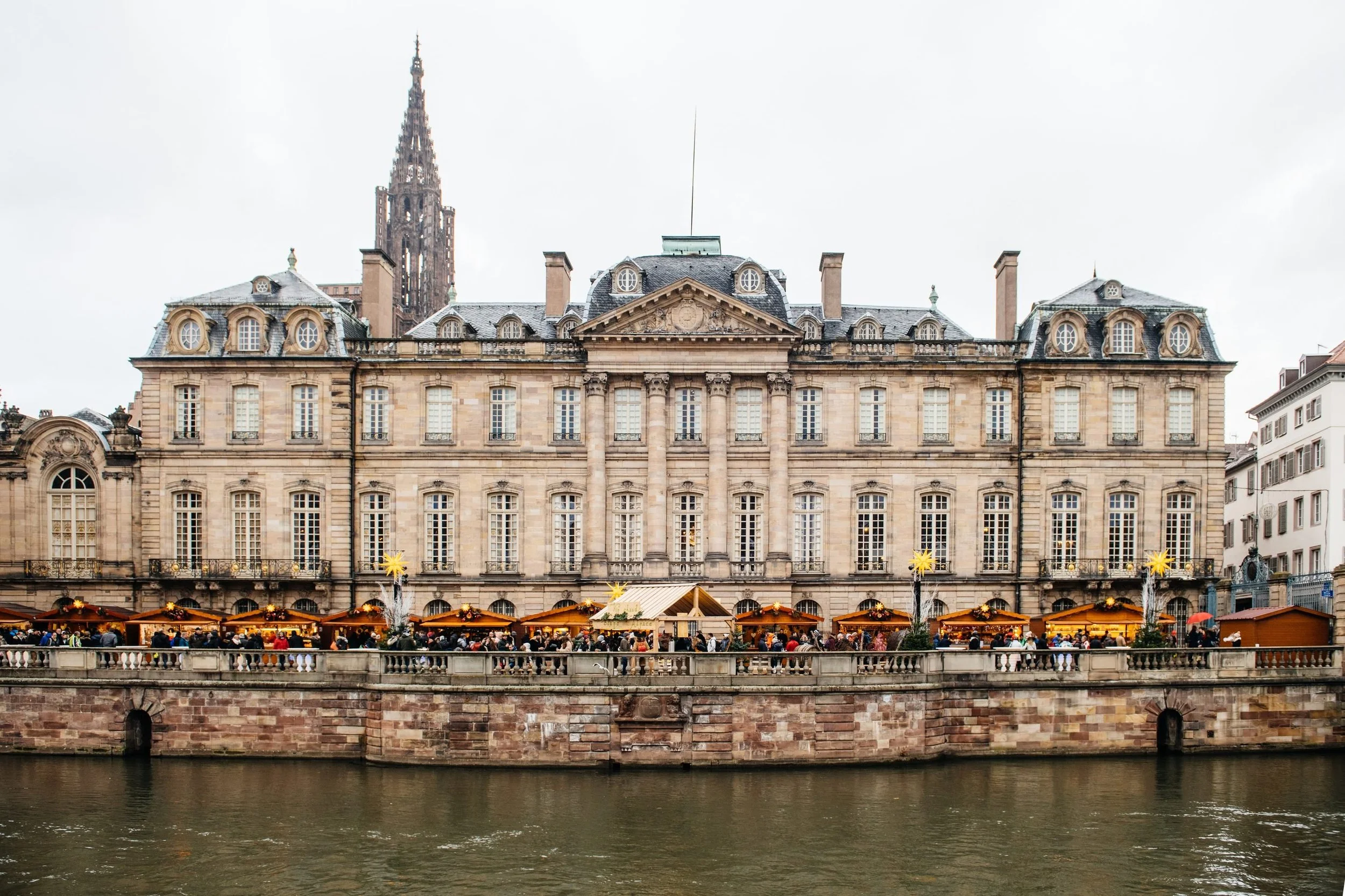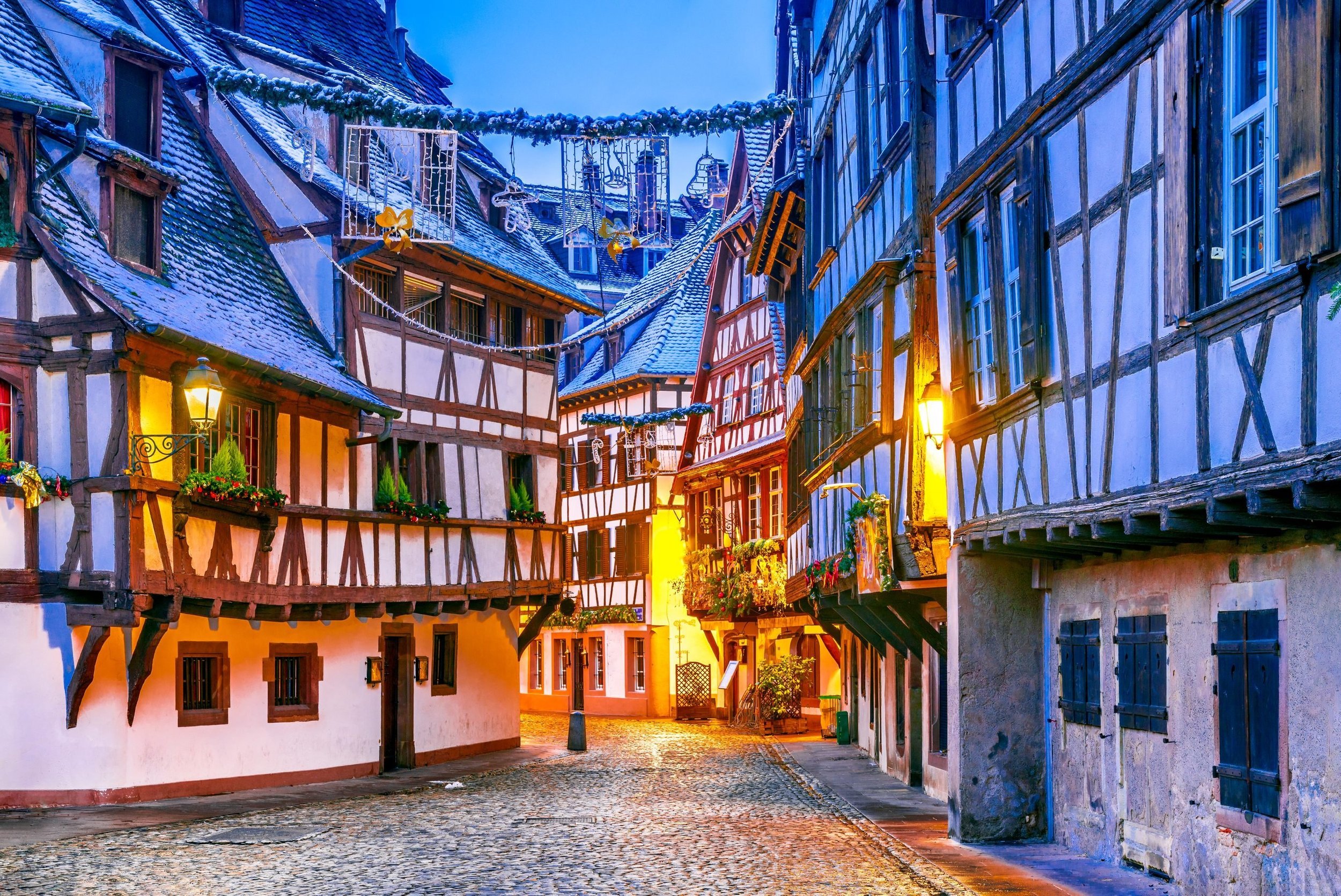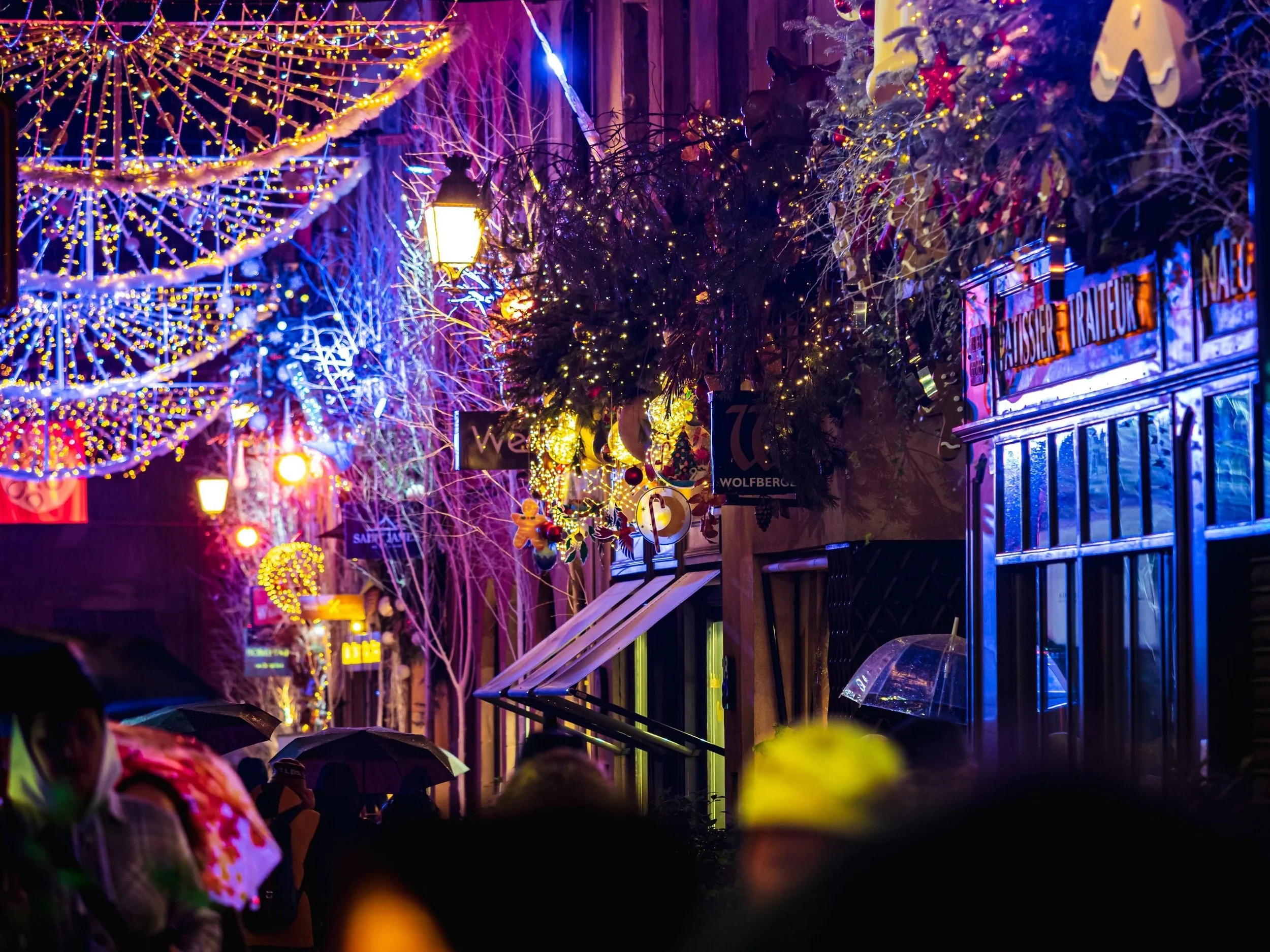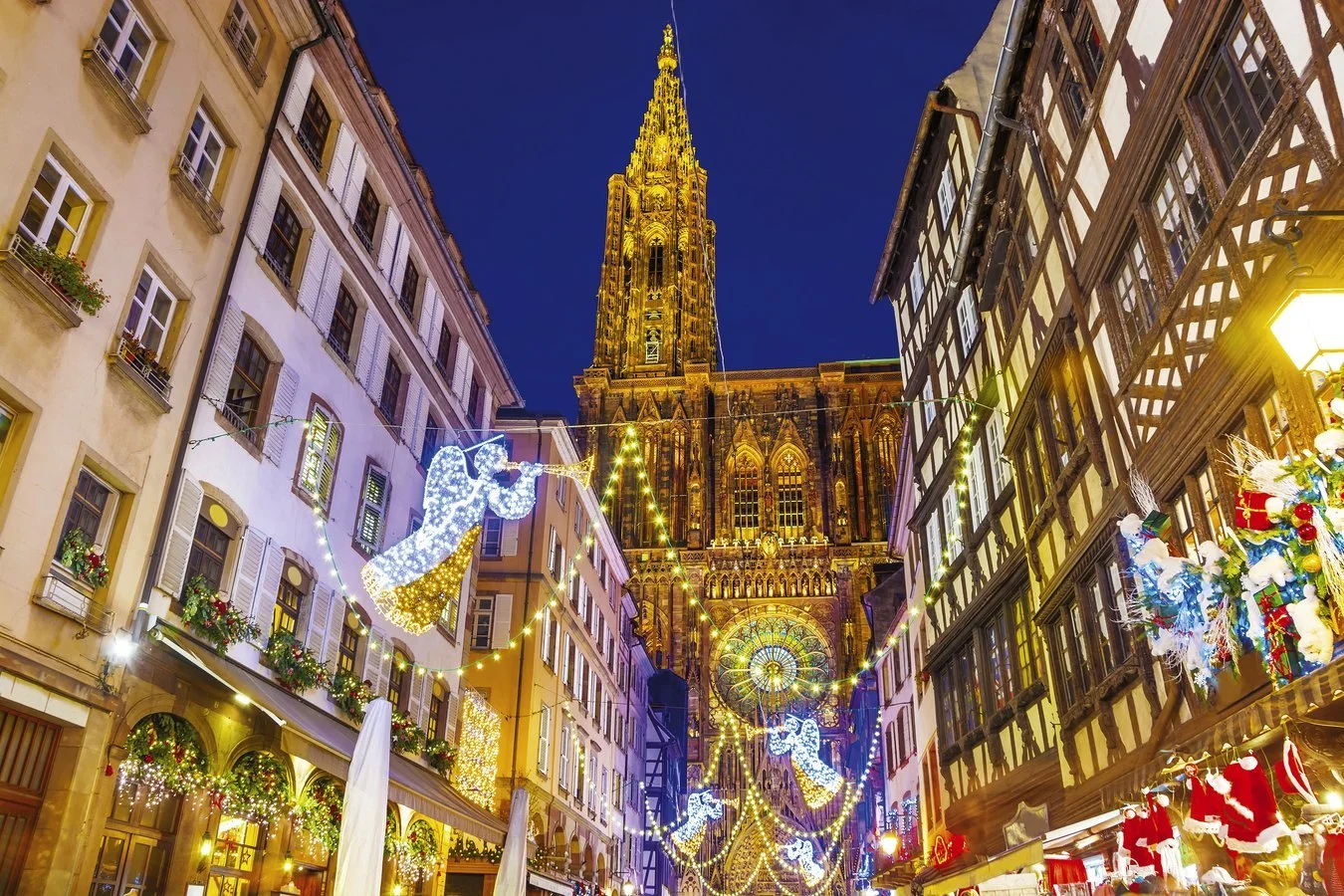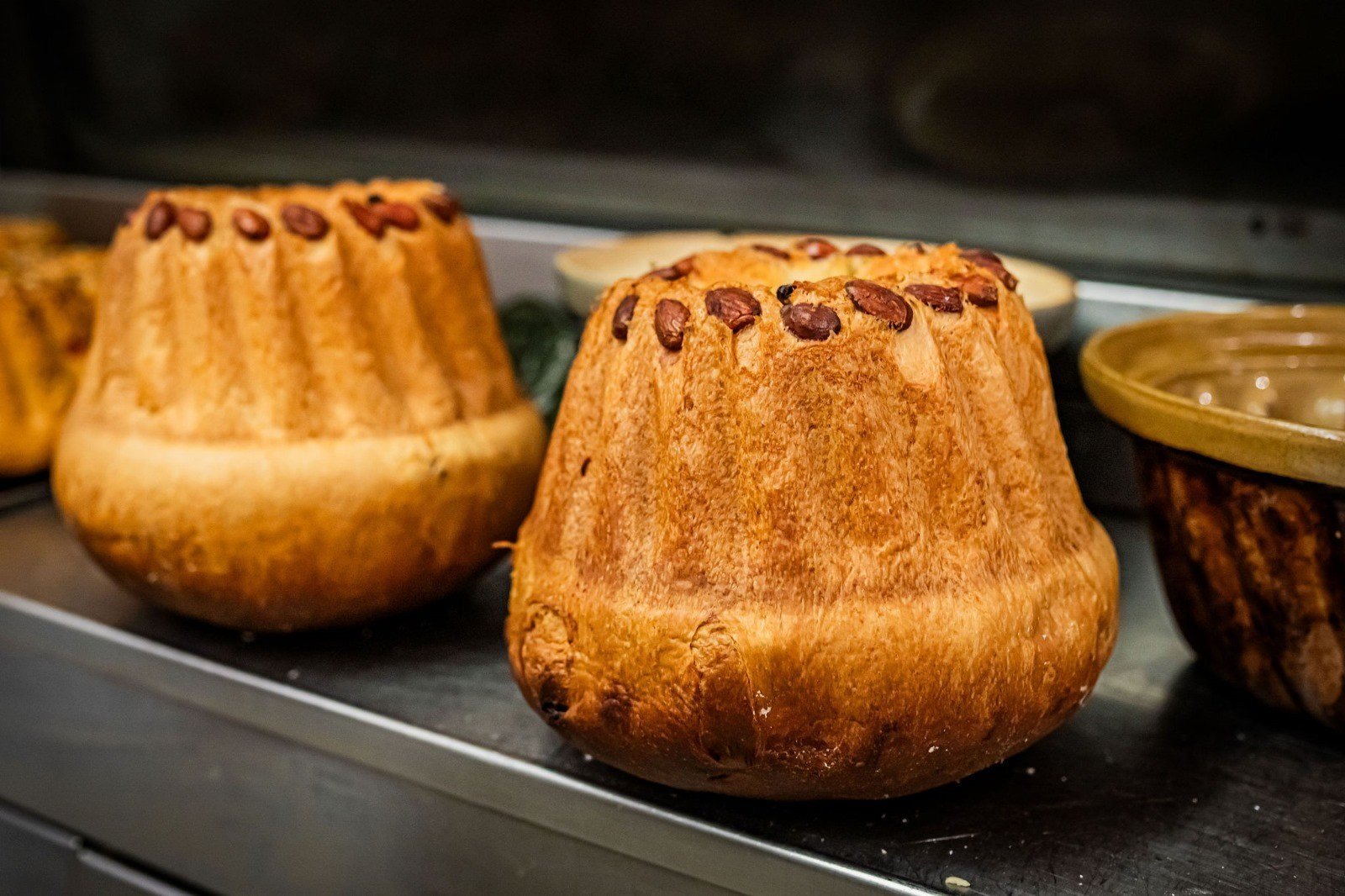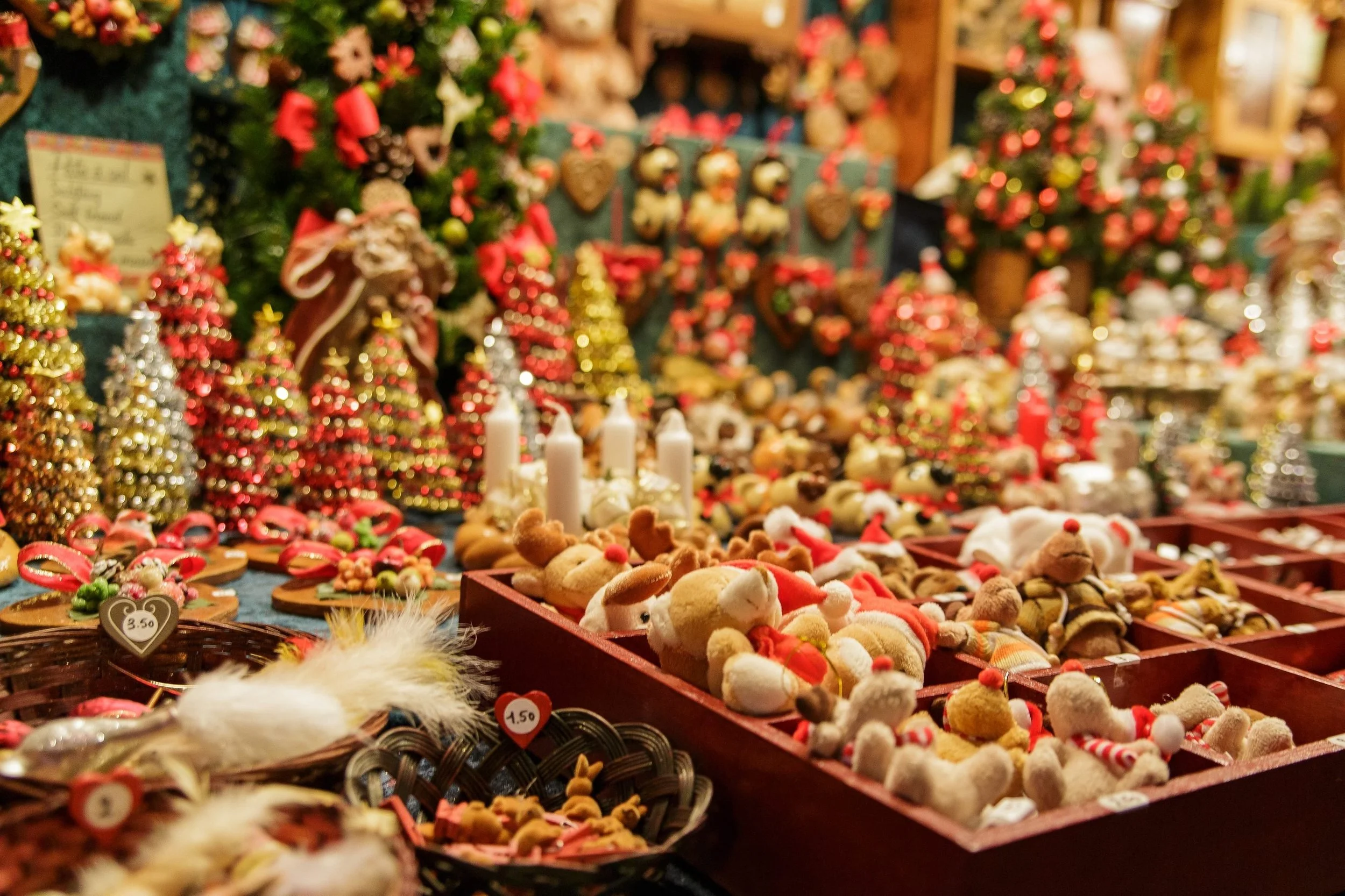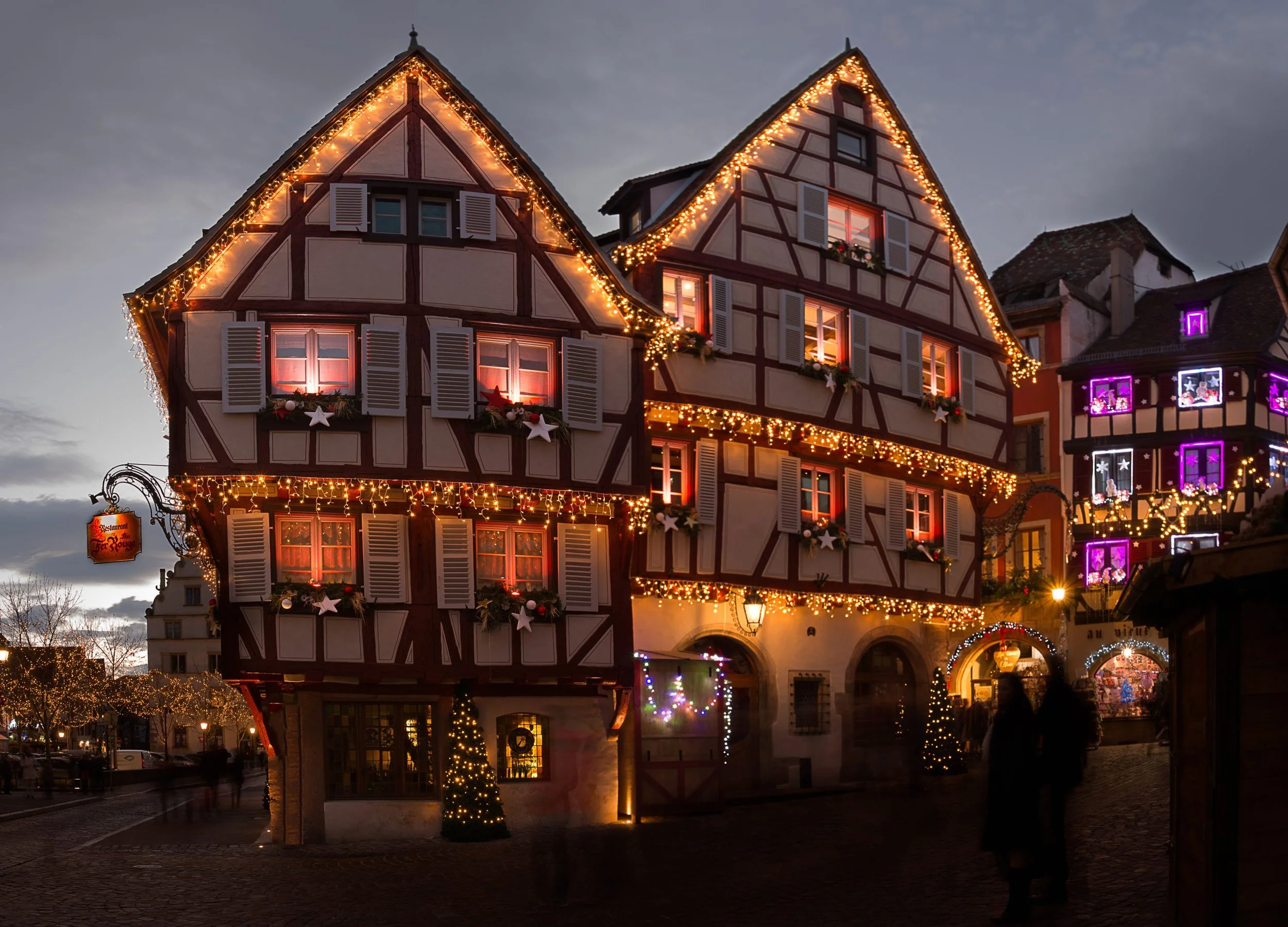A Local’s Guide to the Strasbourg Christmas Markets 2025
This blog post may contain affiliate links. I may earn a small commission for any purchases made through these links. Click here for the disclosure statement.
There’s nothing quite like Christmas in Strasbourg, France. Nestled in the heart of Alsace, this region is unlike anywhere else in the country with both French and German influences.
Called the “Capital of Christmas”, Strasbourg is home to eight unique Christmas markets, each with its own charm and character. The most iconic, the Christkindelsmärik, dates all the way back to 1570, making it the oldest Christmas market in France. What began centuries ago as a humble fair has now grown into a magnificent winter village that welcomes millions of visitors each year.
During the festive months, every corner of Strasbourg sparkles under a legion of twinkling lights and Christmas decorations strung on every storefront. The air fills with the scent of gingerbread, mulled wine, and roasted chestnuts. An enormous fir tree tower over the historic Place Kleber, while hundreds of wooden chalets sell handcrafted ornaments and local delicacies.
The Strasbourg Christmas markets create an utterly enchanting ambiance that even a self-proclaimed Scrooge couldn’t help but feel the holiday spirit.
In this guide, you’ll find everything you need to plan your visit for the 2025 Strasbourg Christmas Market, from dates and opening hours to insider tips from a local, plus my recommendations on what to eat, drink, and where to stay for the most magical holiday getaway.
Strasbourg Christmas Market Dates & Hours
When does Strasbourg Christmas market start? This year, the Strasbourg Christmas markets will be open from November 26 to December 24, 2025.
The chalets (market stalls) are open daily from 11:30 a.m. to 9:00 p.m. except for November 26 (2:00 p.m. to 9:00 p.m.) and December 24 (11:30 a.m. to 6:00 p.m.)
As a Strasbourg resident of 5 years now, I can tell you the markets get busier week by week. The best time to visit is in late November or early December when the festivities have just kicked off but you’re not pushing your way through crowds. Closer to Christmas, more and more visitors arrive, and it’s almost like New Year’s Eve in Time’s Square!
You can also avoid the traffic by visiting on weekdays. Crowds are usually less dense on Mondays and Tuesdays, while Wednesdays and weekends are far busier.
How to Get to Strasbourg
Strasbourg may sit on the French-German border, but getting there is surprisingly easy, whether you’re coming from Paris, another part of Europe, or farther abroad. The city is well-connected by train, plane, and car.
By Plane
If you’re flying from another European city, Strasbourg Airport (SXB) is small but convenient, located only 10 kilometers from the city in Entzheim. From there, a regional train brings you to the city center in under 15 minutes. You can purchase a single train ticket on the station platforms or a combined TER + CTS (train + bus and tram) ticket from the ticket machine in the airport.
For more flight options within Europe, you can also fly into nearby airports like EuroAirport Basel-Mulhouse-Freiburg (BSL, EAP, MLH) (about 1.5 hours away) and hop on a connecting train.
If you’re traveling to Strasbourg from outside of Europe, the easiest route is to fly into a major international hub like Frankfurt Airport (FRA), Paris Charles de Gaulle Airport (CDG), or Zurich Airport (ZRH). Strasbourg’s own airport (SXB) primarily serves domestic and short-haul European flights, so most long-distance travelers arrive through one of the larger airports nearby and continue to Strasbourg by train or a short regional flight.
Frankfurt Airport (FRA) is about 220 kilometers (135 miles) northeast of Strasbourg. It’s roughly 2.5 hours away via high-speed ICE trains and routes run several times a day.
Insider tip: I always fly out of Frankfurt when I visit the U.S. The airport is typically calmer than Paris, and flights are often cheaper and less crowded too.
Paris Charles de Gaulle Airport (CDG) is located roughly 490 kilometers (300 miles) to the west and connects to Strasbourg by TGV high-speed train in about 2 hours. Departures are directly from the airport terminal.
Zurich Airport (ZRH) is around 220 kilometers (135 miles) to the southeast of Strasbourg and takes approximately 3 hours by train. Traveling in and out of Switzerland can be pricey, which is why I typically avoid this route.
By Train
The quickest and most scenic way to reach Strasbourg is by train. Strasbourg is a major railway hub with connections across France and Europe.
From Paris Gare de l’Est (if you’re traveling from the center of Paris) or Paris Charles de Gaulle Airport (if you’re traveling from the airport), the TGV gets you to Strasbourg in about two hours.
Direct connections also run from cities like Zurich, Basel, Frankfurt, Stuttgart, Lyon and Brussels, normally taking 2–3 hours depending on the city.
To explore other famous towns in Alsace, like Colmar, and fairytale villages like Riquewihr, Eguisheim, and Kaysersberg, the train ride is only about 30 minutes.
Gare de Strasbourg-Ville, the main train station, is a short walk from the central square and most hotels. Buses and taxis are located just outside to take you to your accommodations too.
Insider tip: If you’re planning to explore Alsace and nearby Germany, consult all current ticket offers. The Alsa + Groupe Journée pass costs €45 on weekends and public holidays and allows a group of 2–5 people to travel throughout all of Alsace.
By Car
Many visitors rent a car to explore the scenic Alsace wine region, but driving in Strasbourg itself requires a bit of planning, especially during the busy Christmas season.
The city is about 5 hours from Paris and less than 2 hours from Stuttgart or Luxembourg.
Parking in the city center is limited, and Grande Île is closed to traffic starting in late November, so even hotels with parking garages may restrict access.
The easiest way to park is by using one of Strasbourg’s 12 park-and-ride (P+R) lots located along all tram lines. A P+R ticket costs €4.20 and includes unlimited access to the CTS tram and bus network for up to 7 passengers, including the driver.
These car parks are open seven days a week, with exit possible 24 hours a day. You can park between 4:30 a.m. and 2:00 a.m. the following day, then hop on a tram to reach the heart of the Christmas markets quickly and easily.
A full map of all 12 P+R locations is available here.
Where to Stay in Strasbourg
Strasbourg has accommodations for every style and budget, from adorable boutique hotels that look straight out of a Disney movie to modern luxury properties just steps from the Christmas markets. Here are some of my top picks for places to stay in Strasbourg:
Best luxury hotels: Hôtel Léonor, Hôtel Les Haras
Most charming: Hôtel Cour du Corbeau, Hôtel Suisse
Best budget-friendly hotels: The People Hostel, Hôtel Arok
Best outside of the city center: Château de Pourtalès, Boutique Hôtel des XV (both in the posh residential area of Strasbourg that’s usually much calmer than the city center)
Near the train station: Hôtel Tandem, Best Western Plus Hôtel Monopole Métropole
Photo credit: Hôtel Cour du Corbeau
There are also plenty of Airbnbs in the city center. Many locals even rent out their apartments during this season to make extra income (and get away from the holiday bustle).
Looking for hotels near the Strasbourg Christmas market? Staying in or near Grande Île, the city’s UNESCO-listed historic center, puts you within walking distance of the cathedral, canals, and main market squares. Keep in mind that prices can be quite high on the center island.
If you’re on a budget or booking last minute, don’t overlook areas a little outside the center. Strasbourg’s tram system is excellent and can take you to the center in minutes. You can even reach just over the German border in about 30 minutes!
Neighborhoods like Contades, Forêt Noire, Orangerie, La Robertsau, Wacken, and Neudorf are all excellent choices outside of the center island. They’re safe, well-connected, and mostly residential areas for families.
Esplanade and Krutenau are honorable mentions. Both are lively student areas a bit farther from the markets but still pleasant if you don’t mind a short tram or bike ride.
Ilkirch, a bit farther out, is ideal if you don’t mind taking the tram into the city center.
Photo credit: Hôtel Léonor
Where to Not Stay in Strasbourg
There really aren’t many “unsafe” parts of Strasbourg (unlike Paris and Marseille where you do have dangerous areas). Still, there are a few neighborhoods where it’s best to stay alert, especially if you’re alone at night.
Gare. The area around the train station is generally safe but can feel a bit sketchy after dark. If you’re traveling solo, stay aware of your surroundings and avoid wandering here late at night.
Neuhof. This residential area, located south of Neudorf (which is a great and safe area), isn’t the best place to stay. The neighboring Meinau also has a few rougher spots.
Hautepierre. Known for a higher crime rate, it’s not an area I’d suggest staying in, and to be honest, you’ll have little reason to go there as a visitor. The nearby Cronenbourg neighborhood is similar. It’s fine to pass through during the day, but I wouldn’t walk around there alone at night.
Insider tip: Book early. Hotels and Airbnbs fill quickly during the Christmas market season and organizing your accommodations well in advance ensures the best options and rates.
How to Get Around Strasbourg
Walking is truly the best way to experience Strasbourg at your own pace.
To give you an idea of scale, it takes about 15 minutes to walk from one side of the island to the other. Since most of the markets are close together, exploring on foot is not just convenient, but an excellent way to see more of the city.
Surrounded by the Ill River, the city’s historic center is closed to cars throughout the event, meaning only pedestrians and bikes are allowed.
There are 21 bridges leading into the Grande Île that remain open 24/7 for pedestrians, so you can get on and off the island easily.
During market hours (11:30 a.m. to 9:00 p.m.), bag checks are conducted at the main entrances. There are so many access points that you normally don’t have to wait too long.
If you’re staying outside the city center, take advantage of the tram. It’s clean, efficient, and connects directly to the main markets, with stops at Place Broglie, Homme de Fer, and Langstross Grand’Rue.
You can buy tickets through the CTS Strasbourg app or at the kiosks near the tram stops. Just be sure to validate it before boarding at one of the tall red machines located on the tram platforms (not inside the trams themselves).
You can also rent a bike through Vélhop, the city’s public bike-share system. However, during peak market hours, the narrow streets of the Grande Île can get crowded, so it’s best to leave the bike on the outskirts of the island and enjoy the Christmas markets on foot.
Strasbourg Christmas Market Locations
Where is the Strasbourg Christmas market? There isn’t just one, but rather 8 markets throughout the historic center, all within easy walking distance of each other. Among some of Strasbourg’s most famous streets and squares, you’ll find hundreds of stalls offering traditional foods, artisanal crafts, seasonal decorations, and more.
This interactive map is helpful for finding market locations in Strasbourg. Here’s a quick rundown of the 8 Strasbourg Christmas markets and what makes each one special.
1. Christkindelsmärik at Place Broglie
Christkindelsmärik, which means “Market of the Christ Child” in Alsatian, is Strasbourg’s historic Christmas market and a true must-see. Founded in 1570, it is one of the oldest Christmas markets in Europe and was, for a long time, the only one in France.
Over the centuries, the market moved between locations like the cathedral square, Place du Château, and Place Kléber, before finally settling in Place Broglie in 1871. Today, it remains a central part of Strasbourg’s Christmas festivities.
At one end of the market, the Strasbourg Opera House is the perfect spot to snap photos of the entire market. On the other end, you’ll find the beautiful Hermès boutique and the iconic Café Broglie with its lovely terrace.
Although I have a soft spot for the smaller markets, this one is a must-visit for its history alone.
Insider tip: Don’t miss the chance to snap a photo under the iconic Christkindelsmärik arch.
2. Cathédrale Notre-Dame
The market at the Cathédrale Notre-Dame is one of Strasbourg’s most popular, and it’s easy to see why. The cathedral’s towering Gothic facade dominates the square and is steeped in tradition and history.
Before Christkindelsmärik, Strasbourg hosted a “Klausenmärik” or Saint Nicholas market in this same area around December 6. Medieval stalls sold candles, gingerbread, and other treats alongside herbalists, leatherworkers, second-hand merchants, and haberdashers. Today, the market stretches from Place de la Cathédrale to Place du Château, along Rue des Hallebardes and Rue Gutenberg.
For the ultimate perspective, you can climb the cathedral tower. From 66 meters up, you get a panoramic view of the Christmas markets, rooftops, and canals below. I’ve done it a few times myself, so here’s my advice: be ready to walk, because it’s quite a climb, but it’s absolutely worth it.
Don’t miss the astronomical clock on the back of the church that shows complex calculations for the time, planets, and moon phases.
Insider tip: Nearby, you’ll also find the Maison Kammerzell, one of Strasbourg’s most famous buildings and one of the most well-preserved late Gothic buildings. Many French celebrities and politicians have eaten here, and the restaurant inside is famous for its fish sauerkraut.
3. Place Kléber
Located in the heart of Strasbourg, Place Kléber is another market you simply cannot miss. The highlight is undoubtedly the 101-foot Christmas tree adorned with thousands of twinkling lights that recall the Eiffel Tower at night.
Every evening from 4:00 p.m. to 9:00 p.m., the tree comes alive with a musical and light show, with the lights remaining on until midnight.
This area attracts crowds, so expect it to be busy, but it’s a must-see spectacle that reminds us why Strasbourg is called the Capital of Christmas!
At the base of the grand sapin (giant Christmas tree), you’ll find the Village du Partage, where 110 associations rotate throughout the season to promote solidarity, fraternity, and humanist values.
Nearby, the Aubette hosts seasonal events such as Noël des Brocanteurs (November 26 to December 7) and the Salon Oz - Noël des Métiers d’Art (December 12 to 22), celebrating local craftsmanship and artisanal work.
You can even taste a soup prepared by starred chefs from the region, organized by the Humanis collective. This is one of my favorite market stalls in Strasbourg that I look forward to every year. Even though I enjoy the traditional Alsatian food sometimes, the soup is always incredible!
4. Carré d’Or Market at Place du Temple Neuf
Just a short stroll from the cathedral, the Carré d’Or Market is known for its historic charm and picturesque setting in front of the Lutheran church.
Take the time to wander the surrounding streets, including the famous Rue des Orfèvres, beautifully illuminated for the season. Along the way, discover the city’s best cheesemonger (Maison Lohro) and chocolatier (Chocolat Weiss). You’ll also find delicious pastries and baked goods at Naegel.
The street is also home to beautiful boutiques including Carpe Diem for affordable jewelry, Dammann Frères (don’t miss their Strasbourg Cathedral tea for a perfect souvenir), Le Tanneur for elegant French handbags, and Eric Bompard for luxurious knitwear.
5. Place du Marché-aux-Poissons and Terrasse Rohan
The “quai des délices” (dock of delicacies) as it’s called, this market is a favorite for foodies. Here, the bakers of the Bas-Rhin Bakers’ Federation present their famous Bredele (traditional Alsatian Christmas cookies).
Right next door, at Place du Marché-aux-Poissons (Fish Market Square), the feast continues. Local producers showcase Alsatian specialties like vin chaud, mannele (little brioche men), regional wines, and even local honey.
On the terrace of the Palais Rohan, the Tribu des Gourmets offers fine wines from nearby vineyards.
From the terrace, take a moment to admire the 400 glistening stars suspended in the trees and enjoy a slow stroll along the canals. One of the most enchanting winter scenes in Strasbourg.
6. Square Louise Weiss
Called the “irréductibles petits producteurs d’Alsace”, the market at Square Louise Weiss showcases lots of local goods to try and take home.
For those with a sweet tooth, there’s artisan chocolate, homemade jams, and Bredele cookies, while the beverage stands serve local wines and hot apple juice (a non-alcoholic alternative to vin chaud).
In the same square, you’ll also find the Advent Village, a magical space designed for families. Here, children and parents can join creative workshops to craft Advent wreaths, ornaments, and holiday cards, or enjoy concerts and storytelling sessions performed by local artists and music students.
Just nearby, the Covered Bridges and Vauban Dam are also worth a visit. From the rooftop of the dam (don’t worry, it’s not as high as the cathedral!) for lovely views of Strasbourg’s old town and the cathedral.
7. La Petite France
La Petite France is a must-visit year-round, but at Christmas, it truly shines (almost literally). This fairytale quarter, with its half-timbered houses, cobblestone streets, and winding canals of the Ill River, feels like a tiny Alsatian version of Venice.
Insider tip: Stroll across the picturesque Pont du Faisan (the “swivelling bridge” as the locals call it), and pause to watch boats drift along the canal. The scene is like stepping into another time.
During the holidays, Benjamin Zix Square and Saint Thomas Square transform into cozy Christmas villages, filled with wooden chalets and twinkling lights.
8. Le Marché OFF at Place Grimmeissen
The Marché OFF is Strasbourg’s most unconventional Christmas market where festive spirit meets social responsibility. This year, it’s also celebrating its 10th anniversary!
The OFF Market has become a favorite among younger locals. Here you can shop secondhand clothing and furniture, handmade crafts, books, and toys. There are several organic and vegan food options too. Everything is unique and ethical, including shipping containers turned into chalets.
Insider tip: I always make a point to visit for the Paye Ton Noël concerts, but there’s so much more happening throughout the season. You can find talks, performances, workshops, and creative events listed on marcheoffstrasbourg.fr.
There’s even a “Safe Zone” rest area for visitors with disabilities that offers sensory items like noise-canceling headphones, blankets, and stress balls. This year, the market is also introducing a parent-child area with a microwave, changing table, and comfortable seating.
It may be the least traditional of Strasbourg’s Christmas markets, but it’s probably one of my favorites in the city.
Map of Strasbourg Christmas Markets
Christmas Displays and Storefronts in Strasbourg
One of the most magical parts of visiting Strasbourg during the holidays isn’t just the markets, but the storefronts themselves. The city goes all out. I start seeing decorations and lights start going up in October here!
Nearly every shop, café, and restaurant dresses its façade with glittering garlands, twinkling lights, plush teddy bears and whimsical ornaments. Walking through the historic center feels unreal, and here are some of the best Christmas displays, alleys, and storefronts to add to your itinerary.
Rue des Orfèvres
One of the most iconic streets to stroll down is Rue des Orfèvres. Just steps from the Cathedral, this charming passageway leads straight to the Carré d’Or Market. Strings of golden lights twinkle between buildings, and every storefront is decked out with garlands, ornaments, and ribbons.
One of the most photographed streets in Strasbourg, it’s often very crowded, so embrace a slower pace and take it all in. Read above for my favorite shops on this street (especially if you love cheese and chocolate)!
Rue du Chaudron
About halfway down Rue des Orfèvres, turn onto Rue du Chaudron to see The House of Hanssen & Gretel and its fairytale façade. You can go inside to shop for Christmas decorations or just stop in front to snap a photo.
Rue du Maroquin
Rue du Maroquin is another famous street not far from the Cathedral. Here you have one of the city’s most beloved sights, the Teddy Bear House at Le Tire-Bouchon restaurant, on the corner of Rue du Maroquin and Rue des Tailleurs de Pierre. It’s adorned with plush bears from top to bottom, even more charming in person than it is in every postcard.
Rue des Tonneliers
Once used by deliverymen rolling wine barrels from the docks, Rue des Tonneliers now pays tribute to its past with whimsical lighting featuring glowing barrels suspended above the street. There are also several incredible restaurants on this street: La Cloche à Fromage, Restaurant Au Petit Tonnelier, Pompette, Zuem Winkuewele.
Rue du Bain-aux-Plantes
In the heart of Petite France, Rue du Bain-aux-Plantes is one of the city’s most picturesque cobblestone streets. Framed by half-timbered houses and canal views, it’s home to some of the area’s coziest restaurants, like the traditional Lohkäs restaurant.
Rue Mercière
Another picture-perfect spot just off the Cathedral square, Rue Mercière offers one of the best views of the Cathedral framed by glittering lights and festive décor. It’s one of those classic Strasbourg shots you’ll definitely want for your Instagram photo dump.
Pâtisserie Christian
Pâtisserie Christian is one of Strasbourg’s most famous pastry shops, and its Rue de l'Outre location is a popular photo spot year-round. I always spot tourists taking photos in front of its beautiful facade painted by Edgar Mahler. During the Christmas markets, it’s even more photo-worthy, dressed in holiday decor.
Galeries Lafayette
The Galeries Lafayette department store in Strasbourg is beautifully illuminated for the season with a grand holiday display and windows decked to the nines. Unlike the Galeries Lafayette in Paris, it doesn’t feature a gargantuan Christmas tree inside, but it’s still worth stopping by just to admire the festive décor.
What to Eat and Drink at the Strasbourg Christmas Market
One of the best parts of visiting the Strasbourg Christmas markets is all of the delicious food. Trust me, you’ll want to arrive hungry. This is one of those times when it’s totally fine to skip the restaurant reservations because the markets themselves are like one giant open-air dining experience.
All around you, wooden chalets serve up steaming Alsatian specialties that are known for their mix of French and German influences. Most dishes cost between €5 and €15, so you can easily snack your way through the markets without spending too much. Below is a guide to the must-try Strasbourg Christmas market food and drinks:
Savory
Tarte flambée (flammekueche). A super thin crust topped with crème fraîche, onions, and lardons (tiny bacon cubes). It’s Alsace’s signature dish, and one that every visitor should try. Of course, the best tarte flambée is normally found in small Alsatian villages around Strasbourg, but the Christmas market version is still one to sample.
Baguette flambée. Like a tarte flambée, but on a baguette. Super practical to eat while you peruse the stalls.
Choucroute. Sauerkraut simmered with a variety of meats like sausage, ham and knacks d’Alsace (smoked sausages from Alsace).
Grumbeerekiechle. Crispy Alsatian potato pancakes.
Spätzle. An egg noodle from Germany, often tossed with cream, onions, and lardons.
Bretzel. Soft pretzels with salt, sesame seeds, cheese and other toppings.
Foie gras. Duck or goose liver. Foie gras production is a very old tradition in Alsace, and at the Strasbourg Christmas Market, you can enjoy it on a gourmet sandwich from Maison Doriath on the Place du Marché aux Poissons.
Sweet
Bredele. Traditional Alsatian Christmas cookies in dozens of shapes and flavors like cinnamon, almond, lemon, chocolate and anise.
Kougelhopf. A soft, ring-shaped cake traditionally made with raisins and almonds. It’s a very festive Alsatian treat. You’ll also find mini versions that are basically cupcake-sized to enjoy in individual portions. If you’re strongly anti-raisin, I’ve also seen other variations, including chocolate chip.
Mannele. Brioche men with eyes made of raisins or chocolate chips, traditionally eaten on Saint Nicholas' Day.
Pain d’épice. French gingerbread rich with honey and spices. Later on, I’ll share exactly where to find the best one in Strasbourg.
Crêpes and gaufres. Classic French crêpes and waffles topped with Nutella, chestnut cream (crème de marron), or sugar.
Roasted chestnuts. Hot, smoky chestnuts to snack on while strolling through the markets. You’ll see stands for these all over Strasbourg that look like mini trains.
Photo credit: Kougel by Heiligenstein
Drinks
Vin chaud. Hot, mulled wine (red or white) infused with cinnamon, cloves, and citrus. You’ll pay one euro for the plastic cup it’s served in, which you can keep as a souvenir or return for your deposit back.
Hot apple or orange juice. A non-alcoholic alternative with apple or orange and spices.
Alsace wines. Riesling, Pinot Gris, or Gewürztraminer, there are several regional wines at the market to sip on.
Local beer. Alsace boasts several breweries. At the Christmas market, look out for festive Christmas beers, and even hot beer if you’re feeling adventurous.
Chocolat chaud. Creamy French hot chocolate. It’s typically not as thick as other European-style hot chocolates.
What to Buy at the Strasbourg Christmas Markets
Visiting Strasbourg at Christmas is also the perfect time to shop for unique, locally made gifts. From traditional Alsatian crafts to gourmet treats, the markets are packed with souvenirs to bring home. Here are some of my favorites:
Christmas Ornaments & Decorations
Handcrafted wood and glass ornaments featuring traditional Alsatian motifs (storks, half-timbered houses, bretzels, tiny gnomes, and other festive designs. There are tons of options, but watch out for mass-produced “Made in China” souvenirs. As you wander the markets, it’s easy to discern what’s truly local versus what isn’t.
Bredele
These small Alsatian Christmas cookies appear at nearly every stall. While the “best” is subjective, a popular place to pick them up year-round is the Maison Alsacienne de Biscuiterie. Their atelier is based in Colmar, but they have boutiques throughout Alsace. I love grabbing a few biscuits here to bring back to my family in the U.S.
Local Food Products
Alsatian specialties like foie gras, cheese, honey, and regional sausages make excellent souvenirs to share with family and friends back home. Many markets (see above) host local artisans selling unique products, so check the stalls carefully to find the best selection.
Gingerbread
You’ll find plenty of gingerbread at market stalls, but the finest comes from Mireille Oster. Their homemade gingerbread is a delight, even for those who aren’t normally fans. You’ll also find Alsatian treats like candied and glazed chestnuts, lace crêpe kougelhopf, and anis-flavored Bredele. They even recently opened a new boutique in Strasbourg!
Photo credit: Mireille Oster
Alsatian Wines and Spirits
Bring back a bottle or two of the region’s renowned wines: Gewürztraminer, Riesling, and Crémant d’Alsace (the local, more affordable alternative to Champagne). There are several local cavistes who can help you pick the perfect bottle for your taste and budget.
Insider tip: I personally recommend Oenosphere, a wine store and bar in Krutenau. The staff are very knowledgeable and friendly, and it’s where I myself shop for wine!
Alsatian Wine Glasses
If you pick up some wine, you might need some fancy new drinkware to go with it. These traditional Alsatian glasses have green stems and wide bowls that are said to enhance the floral notes of white wine while reflecting its pale hues. Whether or not that’s true, they still make an adorable keepsake.
Wooden Toys
Alsace, along with neighboring Germany, has a long tradition of crafting handmade wooden toys that make beautiful keepsakes or gifts for children. Many talented artisans sell these at the Christmas markets, but one of my favorites is Brin d’Ours, whose toys are available only during the holiday season.
Their production is entirely artisanal and intentionally limited, and all their toys are crafted from linden wood, a native wood found throughout France.
Photo credit: Brin d’Ours
Stork-Themed Souvenirs
The stork is a beloved symbol of Alsace. You’ll see it on everything from ornaments to figurines. Fun fact: Strasbourg successfully reintroduced storks to the region at Parc de l’Orangerie, where over 800 have been born since the 1970s. If you visit Strasbourg in the summer, you can normally see the storks in their nests high up in the trees.
There are also plenty of souvenir shops in Petite France and around the Cathedral selling magnets, keychains, stuffed animals, postcards, figurines, and more. Common motifs include gingerbread men, bretzels, storks, timber houses, the Cathedral, and people in traditional Alsatian dress.
Read More: The Ultimate Guide to Shopping in Strasbourg
What to Wear to the Strasbourg Christmas Markets
Strasbourg in winter can be cold and damp, though more often it’s gray and chilly. Temperatures typically range from around 48°F (9°C) at the end of November to 32°F (0°C) in December, so dressing in layers is essential to enjoy the markets comfortably. Rain is also common, and even light drizzle can make cobblestones slippery and streets wet. It snows occasionally, but there is usually not enough to really accumulate.
You’ll definitely want to layer up. Start with thermal layers, add a sweater and top with a warm coat. You can always remove a layer indoors if needed.
For footwear, choose shoes that keep your feet dry and warm. You’ll be walking a lot, so I always recommend something comfortable like a flat boot or even a sneaker if it’s not too wet outside.
Lastly, array yourself in accessories. Gloves, hats, and scarves to keep you cozy while you explore the markets.
Insider tip: If you arrive in Strasbourg underprepared, there’s a Uniqlo in the city center where you can stock up on thermal layers and winter essentials at very reasonable prices.
Here’s exactly what to pack for the Christmas markets in Strasbourg:
Knitwear. A clear essential for winter that layers under all of your coats.
Thermal layers. Long-sleeve tees, leggings, and tights to trap lots of heat.
Heavy coat. A wool coat or puffer will keep you insulated from both cold and wind.
Scarf, hat, and gloves. Keep yourself bundled up for long days of eating, drinking, and shopping in the city.
Thick socks. Double-layer socks are a game-changer, since walking around can make your feet quite cold.
Sturdy, insulated walking shoes. A chunky, waterproof boot is my favorite option for exploring the markets. I’ll also wear sneakers if it’s not too rainy outside.
Hand warmers. Stay nice n’ toasty with hand warmers. These are especially convenient when temperatures start to approach freezing.
Umbrella. Something small and compact for the occasional drizzle.
Quick Tips for Visiting the Strasbourg Christmas Market
Download the public toilet app. Toilets usually cost €0.50–€1, and many don’t accept cards. This handy app shows free public toilets and some partner restaurants let you use theirs if listed!
Bring cash. Some vendors accept cards, but many small artisanal stalls are still cash-only. It’s best to have euros on hand for food, ornaments, and souvenirs. ATMs are available all over the city center.
Consult the market map. The Strasbourg markets are spread out across multiple squares, so plan your route to see them all without doubling back too much.
Explore beyond the markets. There are so many things to do in Strasbourg at Christmas that don’t involve the markets: concerts, workshops, and cultural experiences. Check the full agenda here.
Dress warmly and wear comfortable shoes. You’ll be walking outside most of the day. Compared to Paris, there are many more cobblestone streets (especially in areas like Petite France), so comfortable shoes are a must.
Book trains and hotels early. December fills up fast, even for day trips.
Skip the tram. Once you’re on the Grand Île, walking is easier and lets you take in more of the city. You really don’t need to take the tram to get from market to market.
Shop on Sundays. Stores are usually closed on Sundays in France. But for the Christmas markets in Strasbourg, they are exceptionally open on November 30, and December 7, 14, and 21, so take advantage!
Best Christmas Markets Near Strasbourg
If you have extra time in Alsace, don’t stop at Strasbourg. The surrounding region is dotted with storybook villages that look straight out of a Christmas card. Many visitors will even stay in Strasbourg, then do several day trips to nearby markets. Here are a few worth visiting:
Colmar
Obernai
Kayserberg
Eguisheim
Riquewihr
Ribeauvillé
Metz
Some nearby Christmas markets are easier to reach by train, while others require a car or a combination of train and local bus, so keep this in mind when planning your visits!
Many travelers choose to rent a car to explore the Alsace wine region. If you’re up for it, it’s a great way to see more of the countryside.
Renting a car for a day or two and parking at one of Strasbourg’s larger parking garages (see the map above!) is often the most convenient option if you plan to do day trips from the city.
Colmar or Strasbourg Christmas Market?
I get this question all the time: should you visit Colmar or Strasbourg for the Christmas markets? Should you take a day trip? Are the two markets really that different?
Honestly, after visiting Colmar dozens of times, I’d say skip it if you’re only spending a day or two in Strasbourg. There’s really no need to squeeze it in. The Christmas market in Colmar is charming, yes, but it feels quite similar to strolling through some of Strasbourg’s prettiest areas, like Petite France.
I even asked several of my local friends (people who’ve lived here their whole lives!) what they thought, and most of them agreed. The food, decorations, and vendors overlap quite a bit between the two markets. You’ll find plenty of mulled wine, Bredele cookies, and handcrafted ornaments right here in Strasbourg without the extra travel time.
If you are set on getting out of Strasbourg for the day, I’d look at smaller markets in villages around Alsace. The selection might be smaller, but they are often a lot less commercial.
On my first trip to Strasbourg for the Christmas markets, long before I moved here, I did exactly that: two days in Strasbourg and a day trip to Colmar by train. I remember being a little disappointed by how similar it was (and even more crowded).
That said, if you do have an extra day to spare, Colmar is still worth visiting for its colorful half-timbered houses and cozy small-town feel. But if you’re short on time, just stay in Strasbourg.
FAQs
Are there mugs available in Strasbourg?
The majority of vendors serve drinks in plastic cups with a small €1 deposit. When you return the cup to any stall, you’ll get your deposit back.
If you love collecting mugs from Christmas markets, there are ceramic mugs sold at certain stalls and souvenir shops.
Even though the plastic cups feel less festive, they also prevent potential hazards from broken mugs!
How crowded is the Strasbourg Christmas Market?
As the Capital of Christmas, Strasbourg’s markets are no doubt busy. The crowds tend to grow week by week, so the best time to visit is in late November or early December, right when the festivities begin but before the masses arrive.
By mid-December, the city gets packed. You can also avoid the traffic by visiting on weekdays. Crowds are usually less dense on Mondays and Tuesdays, while Wednesdays and weekends are far busier.
Do you need a ticket for the Strasbourg Christmas Market?
No tickets are required! The markets are completely free to visit. When you enter the Grande Île, you’ll go through a quick security check, but there’s no entry fee or ticket booth.
How long should I spend at the Strasbourg Christmas Market?
Most visitors spend 2–3 days in Strasbourg to fully enjoy the markets and the beautifully decorated city center.
If you’re short on time, a full day is enough to see the highlights. But if you want to explore nearby places like Colmar or one of the Alsatian villages, it’s worth adding an extra day to your itinerary.
Is there an ice skating rink?
No, there used to be one at Place Kléber, but in recent years, there hasn’t been an ice rink in the city center. Keep an eye on the official Strasbourg Christmas website each season in case it returns!
Are credit cards accepted at the Christmas Market?
Some stalls accept cards, but many food vendors and small artisan booths are cash-only. It’s best to bring euros for snacks, ornaments, and souvenirs. Luckily, there are ATMs all around the city center, so you can easily withdraw cash if needed.
Is the Strasbourg Christmas Market Worth It?
As someone who has lived in Strasbourg and visited the Christmas markets for almost six years now, I can confidently say, yes, they’re absolutely worth it.
The Strasbourg Christmas Market is nothing short of magical. It’s one of the largest and oldest in Europe, with dozens of market squares, incredible food, and festive decorations everywhere.
There’s a reason millions of visitors come every year, and it’s because the experience really does live up to the hype.
If it’s your first time visiting European Christmas markets, Strasbourg is a perfect place to start. It’s big, festive, and beautifully organized. I think it really gives you a taste of everything.
Of course, the crowds can get intense. As a local, I admit it can be frustrating when I’m just trying to run errands during December! But even so, I never get tired of seeing how excited people get when they experience the markets here.
It’s also unlike anything you’ll find in the U.S. The scale, the atmosphere, and even the smells feel so quintessentially European.
Although some stalls sell less authentic, mass-produced items, there are still plenty of local artisans offering truly special pieces and regional delicacies that make it worth your while.
Are you visiting Strasbourg at Christmas? What are you most looking forward to? Let me know in the comments below.



